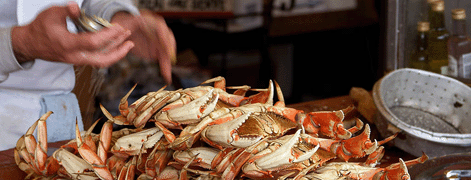How’s fresh crab for dinner sound? Just make a beeline for your favorite fish counter and load up, right? Well, maybe. Or why not go crabbing?

By George Carvalho
Published: December, 2006
Kevin and Bryan Gorman prefer to personally pluck their crabs from the sea. They love taking their boat just outside the Golden Gate Bridge for crabbing. And after five years of doing so, they’ve honed their technique to perfection.
What do these DIY crabbers say is the secret to their success? First off, use the right bait, and they insist frozen squid is the ticket — the crabs just can’t keep their claws off it. But don’t just hang that squid inside a circular crab pot. Instead, put it in a plastic bait jar with a perforated lid. The holes allow the squid scent to circulate, but the jar prevents the bait from being eaten. Toss a fish carcass into the crab trap if you want the live crabs to have something to munch on — a good idea, because the goal is to keep the crustaceans busy until the trap is retrieved. Otherwise, they might slip out and shuffle off sideways en route to a better buffet.
Some crabbers place their traps then go fishing near the Farallon Islands for a few hours before returning to pull up the traps. But the Gorman brothers’ strategy calls for letting the pots sit for extended day soaks. This means making two trips, but they don’t mind. Part of the fun is motoring across San Francisco Bay in their 22-foot Boston Whaler Revenge. And besides, as the proprietor of the Outboard Motor Shop, Bryan, 42, needs to spend quality time with his merchandise.
The first two weeks of the crabbing season in November — before the commercial guys get going — are the best, the brothers say. So that’s when they headed out in 2005, borrowing a bigger boat to take seven friends about nine miles north of the Golden Gate. Everyone aboard had the required sport fishing license —$34.90 for the season or $11.30 for a single day. When the crew pulled up 120 Dungeness crabs in seven traps, each permit holder went home with the full 10-crab quota and big smiles.
Recovering the traps is hard work. They’re placed in 80 to 150 feet of water at the end of 200 feet of line, and a full trap can easily weigh 60 pounds. Hauling traps up would be a cakewalk with a power winch, but the Gormans rely on good old-fashioned hand pulling.
Back at the dock, the crew hoses down the boat, and then it’s time to cook the crabs. Kevin, 41, mans a steam cooker outside. Purists say the best way to eat Dungeness crab is to crack it open and swab it in a little lemon juice and melted butter. Some crab-lovers insist on making crab cakes, salad or bisque, but how the crab is prepared really doesn’t matter. Add some sourdough French bread and wash it down with generous amounts of beer or white wine for a meal worthy of any gourmand.
Crab season this year runs Nov. 11 through June 30, though the pickings are slim late in the season. Check out the Coastside Fishing Club’s crabbing tutorial at www.coastsidefishingclub.com and the California Department of Fish and Game’s Web site at www.dfg.ca.gov for more information. Those without a boat can join a charter vessel. For details, check out www.emeryvillesportfishing.com.
Article originally appeared in the Nov. 2006 issue of Alameda Magazine; published in Bay Crossings with permission.

